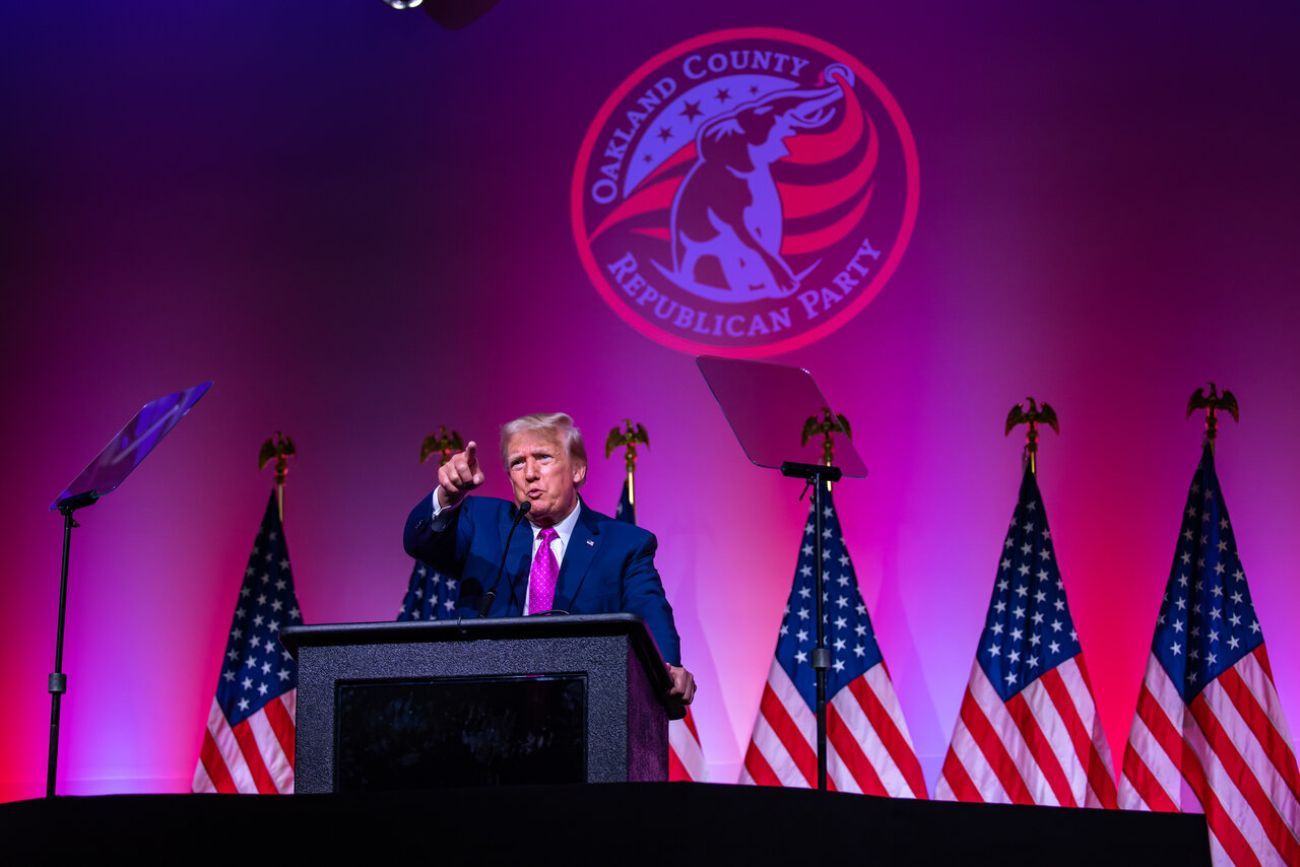Trump in Michigan seeks to win over UAW, blue-collar workers

- Donald Trump and Joe Biden are trying to win Michigan’s blue-collar vote, with both men visiting this week during the UAW strike
- Trump has been more successful than previous Republican presidential candidates in peeling away votes from a traditional Democratic ally
- The UAW has yet to endorse in the 2024 race, but Trump is less focused on winning over UAW leadership than capturing the vote of its members
Former President Donald Trump chose a non-unionized auto supplier factory in Macomb County — the state’s third-largest county and a driver of his victory in 2016 — for his trip to Michigan Wednesday evening.
He’s hunting for support among blue-collar workers in his bid to return to the presidency in 2024, even if union leaders have little use for him.
Trump’s surprise 2016 win in Michigan was fueled by “blue-collar guys who feel that the world has shrunk around them,” said Theda Skocpol, Harvard sociology professor and co-author of “Rust Belt Union Blues: Why Working-Class Voters Are Turning Away from the Democratic Party,” told Bridge Michigan.
Related:
- Biden backs higher pay for UAW workers during historic picket line visit
- Fain pushes back as Trump plans Michigan trip to court UAW
- Biden to walk Michigan picket line with striking UAW workers
- Trump World lands on Mackinac as Michigan GOP sets presidential caucus plan
It’s a group he continues to target as he focuses on expected job losses as the auto industry shifts toward electric vehicles, and economic threats from other countries, including China.
One day earlier, President Joe Biden visited a striking United Auto Workers picket line in Ypsilanti Township, telling the union that its 150,000 striking workers deserve a pay increase from Detroit automakers.
While Biden bested Trump in Michigan and across the nation in 2020, the UAW strike as the industry transitions toward electric vehicles provides the former president with an opportunity to tap into workers’ anxiety about future job losses.
And in a close presidential election, the candidate with the strongest blue-collar vote is likely to gain an edge. “Biden and Trump are both anxious to keep what they've got in the blue-collar ranks and to do a little better, because it could matter if Michigan is close,” Skocpol said.
Here’s what to know about the visits:
Working class voters matter to both candidates.
When it comes to a presidential election, the state is no longer firmly Democratic, despite Biden beating Trump in 2020 by 2.8 percentage points. From the 1990s through 2012, Michigan voted for a Democrat, then narrowly voted for Trump in 2016, giving him a victory over Democrat Hillary Clinton by 10,700 votes.
A swing back to Trump could happen again, said U.S. Rep. Debbie Dingell, D-Ann Arbor. “Michigan is a purple state,” Dingell said during a recent press briefing.
This fall, the first priority for the UAW needs to be a contract and not politics, Dingell said, as the union strikes General Motors, Ford Motor Co. and Stellantis over a host of demands that include higher pay, more time off and job security, including a “just transition” to increased EVs, which are expected to need fewer workers to produce.
Dingell said the Democratic Party needs to listen to union workers and secure their votes, which they’re attempting to do by championing workers and the UAW, from state officials to Congressional leaders and both U.S. senators.
Which leaves Biden and Trump, who has a huge lead in the polls over other Republicans, to scrap for working class votes.
As it happens, Trump’s blue-collar appeal doesn’t resonate as strongly among unionized workers.
According to an AP VoteCast national poll after the 2020 election, Trump received 62 percent of the votes from white voters without a college degree, compared to 37 percent for Biden. But the president outperformed Trump when it came to union members, 56 percent for Biden to Trump’s 42 percent.
In Michigan in 2016, Trump won about 40 percent of state voters in union households, according to exit polling. But that number fell to 37 percent in 2020 as he faced off against Biden, who casts himself as the most pro-union president in history.
Clinton lost in part because of the blue-collar vote in 2016, as auto-job heavy Macomb and Saginaw counties flipped for Trump, and Genesee County — home to Flint — saw a big swing toward Trump.
Biden regained many of the votes in 2020, rallying in Flint, holding onto Genesee County and regaining Saginaw County. But Biden still couldn’t beat Trump in Macomb.
Biden supports UAW and autoworkers
Biden has been touting his pro-union bonafides on the campaign trail, and noting an increase in union support. He also noted wage gains for the lowest-paid workers and a low unemployment rate as signs of economic improvement, a year after record-high inflation.
This week, Biden ratcheted up his public support for striking UAW members, hoping to secure the labor union’s endorsement. UAW President Shawn Fain has yet to give it, even as he has given the cold shoulder to Trump’s candidacy.
“Joe Biden’s firewall was union made!” Richard Trumka, late president of the AFL-CIO wrote in 2020 after Biden’s victory.
Ray Curry, Fain’s predecessor, stood by Biden not just in elections, but also afterwards on policy matters, such as the signing of the Bipartisan Infrastructure Deal and praising the Inflation Reduction Act, both of which promoted EVs.
But Fain last Friday invited Biden to join the picket line, and the president took him up on the offer.
"We know the president will do right by the working class," Fain said Tuesday.
Trump seeks workers, not unions
While Fain is repeatedly asked whether he’ll endorse Biden or Trump, the former U.S. president isn’t courting the union leadership’s approval with his visit to Michigan.
He doesn’t need to, said Skocpol, since he’s been winning the members’ votes anyway.
“Blue collar men, in particular, have not followed their union leadership endorsement of Democrats for the past decade or two,” Skocpol said.
Trump has actively sought to drive a wedge between union members and their leaders. He announced his trip to metro Detroit by saying he’d talk with UAW workers, but then chose the non-union factory, Drake Enterprises in Clinton Township, for his appearance.
During his presidency, Trump battled with unions, led policies that curtailed their power and insulted union leaders. He’s also encouraged UAW workers to stop paying their dues, and recently criticized Fain, saying his members are “being sold down the river” by the union leader.
At the same time, Trump said the UAW should be endorsing him because they’re aligned over concerns about EV jobs losses, particularly his claim that EV jobs will move from the U.S. to China.
“If I don’t win the election, the autoworkers are ‘toast,’ with our great truckers to follow,” he said on his social media channel, Truth Social.
Manufacturing wages have lost ground
Pay is a key issue for the UAW, which seeks raises of 40 percent over four years.
“You deserve what you've earned, and you've earned a hell of a lot more than you’re getting paid now,” Biden told the UAW on Tuesday.
Data on wages and jobs over time shows why Biden would make that statement in Michigan, and why Trump would target working class voters here.
From 2000 to 2020, manufacturing jobs in Michigan declined 30 percent.
Michigan production workers used to have steep income advantage over workers in other states. In 2000, Michigan workers earned 25 percent more than production workers across the country. No longer. Last year, U.S. production workers earned an average pay of $45,370, while pay in Michigan was $45,450, just a slight increase.
“Production workers still get paid a slight premium in Michigan (0.2 percent), but nowhere near as big a premium as they earned in 2000,” said University of Michigan economist Donald Grimes.
Autoworkers also used to make more than manufacturing workers in other industries, Grimes said, but that gap too has closed.
“The UAW-represented Detroit Three worker has gone from being part of upper-middle class wage earners to being simply part of the middle-class wage earners,” Grimes said.
Data reporter Mike Wilkinson contributed to this report
See what new members are saying about why they donated to Bridge Michigan:
- “In order for this information to be accurate and unbiased it must be underwritten by its readers, not by special interests.” - Larry S.
- “Not many other media sources report on the topics Bridge does.” - Susan B.
- “Your journalism is outstanding and rare these days.” - Mark S.
If you want to ensure the future of nonpartisan, nonprofit Michigan journalism, please become a member today. You, too, will be asked why you donated and maybe we'll feature your quote next time!




